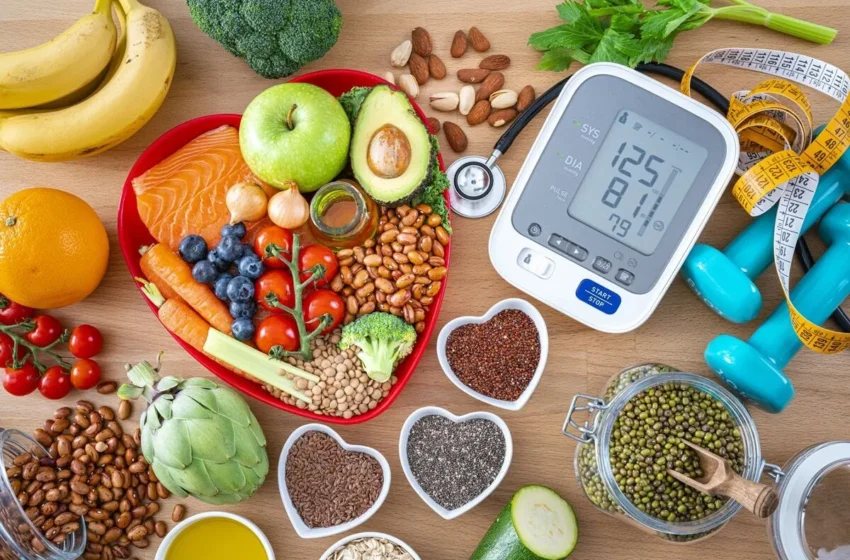Your Guide to a Heart-Healthy Diet

A heart-healthy diet is one of the best ways to protect your cardiovascular health, boost energy, and improve overall well-being. Whether you’re just starting or looking to refine your eating habits, this guide will help you understand what a heart-healthy diet entails, the best foods to include, and how to create a sustainable meal plan.
What Is a Heart-Healthy Diet?
A heart-healthy diet focuses on nutrient-rich foods that support cardiovascular health by reducing bad cholesterol, lowering blood pressure, and maintaining a healthy weight. It emphasizes whole grains, lean proteins, healthy fats, and plenty of fruits and vegetables while limiting processed foods, excess salt, and unhealthy fats.
According to the Mayo Clinic heart-healthy diet guidelines, this approach helps prevent heart disease and promotes long-term wellness.
Heart-Healthy Diet Foods to Include
Choosing the right foods is key to a successful heart-healthy diet plan. Here’s a heart-healthy diet food list to get you started:
1. Fruits and Vegetables
Rich in fiber, vitamins, and antioxidants, fruits and vegetables help reduce inflammation and improve heart function. Aim for a variety of colors for maximum benefits.
-
Leafy greens (spinach, kale)
-
Berries (blueberries, strawberries)
-
Citrus fruits (oranges, grapefruits)
-
Cruciferous veggies (broccoli, Brussels sprouts)
2. Whole Grains
Unlike refined grains, whole grains retain fiber and nutrients that support heart health.
-
Oats
-
Quinoa
-
Brown rice
-
Whole wheat bread
3. Lean Proteins
Opt for lean protein sources to reduce saturated fat intake.
-
Skinless poultry
-
Fish (salmon, mackerel – rich in omega-3s)
-
Legumes (beans, lentils)
-
Tofu and tempeh
4. Healthy Fats
Not all fats are bad! Monounsaturated and polyunsaturated fats help lower bad cholesterol (LDL).
-
Avocados
-
Nuts (almonds, walnuts)
-
Seeds (chia, flaxseeds)
-
Olive oil
5. Low-Fat Dairy (or Dairy Alternatives)
Choose low-fat or unsweetened options to limit saturated fats.
-
Greek yogurt
-
Almond milk
-
Skim milk
Foods to Avoid for a Healthy Heart
To maximize the benefits of a heart-healthy diet, limit or avoid:
-
Processed meats (bacon, sausages)
-
Sugary drinks and snacks
-
Trans fats (found in fried and packaged foods)
-
Extreme salt (leads to high blood pressure)
How Do You Plan a Heart-Healthy Diet?
Creating a beginner heart-healthy diet plan doesn’t have to be complicated. Follow these steps:
1. Set Realistic Goals
Start with small changes, like adding one extra serving of vegetables per day or swapping refined grains for whole grains.
2. Plan Balanced Meals
A heart-healthy diet meal plan should include:
-
Breakfast: Oatmeal with berries and nuts
-
Lunch: Grilled salmon with quinoa and steamed veggies
-
Dinner: Baked chicken with roasted sweet potatoes and a side salad
-
Snacks: Greek yogurt, carrot sticks with hummus
3. Prep in Advance
Meal prepping ensures you stick to your heart-healthy diet plan PDF or printable heart-healthy diet guide. Cook batches of whole grains, chop veggies, and store lean proteins for easy meals.
4. Stay Hydrated
Water supports circulation and helps flush out toxins. Limit sugary drinks and Extreme caffeine.
Heart-Healthy Diet Recipes
Here are some simple heart-healthy diet recipes to try:
1. Mediterranean Salmon Salad
-
Grilled salmon
-
Mixed greens, cherry tomatoes, cucumbers
-
Olive oil and lemon dressing
-
A sprinkle of feta cheese (optional)
2. Quinoa & Black Bean Bowl
-
Cooked quinoa
-
Black beans, diced avocado, corn
-
Lime-cilantro dressing
3. Oatmeal with Almond Butter & Banana
-
Steel-cut oats
-
A spoon of almond butter
-
Sliced banana and chia seeds
Special Considerations
Diabetic Heart-Healthy Diet
If you have diabetes, focus on low-glycemic foods like non-starchy vegetables, whole grains, and lean proteins to manage blood sugar and heart health.
Low-Carb Heart-Healthy Diet
A low-carb heart-healthy diet can include:
-
Leafy greens
-
Lean meats and fish
-
Healthy fats (avocados, nuts)
-
Berries in moderation
Final Tips for Success
-
Read labels to avoid hidden sugars and unhealthy fats.
-
Use herbs and spices instead of salt for flavor.
-
Stay active—exercise complements a heart-healthy diet.
-
Consult a nutritionist for a personalized heart-healthy diet guidelines plan.
Get Started Today!
Whether you follow a Mayo Clinic heart-healthy diet or create your own plan, small changes make a big difference. Download a printable heart-healthy diet guide or a heart-healthy diet PDF to keep yourself on track.
Your heart will thank you!
Would you like a customized heart-healthy diet meal plan? Share your preferences in the comments!


